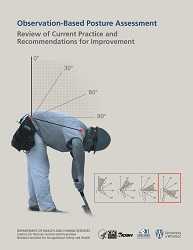Observation-Based Posture Assessment: Review of Current Practice and Recommendations for Improvement
July 2014
DHHS (NIOSH) Publication Number 2014-131
 This document is a joint effort between NIOSH and the Canadian Centre of Research Expertise for the Prevention of Musculoskeletal Disorders (CRE-MSD).
This document is a joint effort between NIOSH and the Canadian Centre of Research Expertise for the Prevention of Musculoskeletal Disorders (CRE-MSD).
The purpose of this document is to help practitioners assess working posture for the prevention and control of occupational musculoskeletal disorders (MSDs). Quantitative or semiquantitative descriptions of posture are inputs to many job analysis tools applied in MSD prevention and control. Studies of the relationship between risk factors (such as posture, repetition, and force) and resulting MSD prevalence have used various approaches to characterizing working posture, including observation-based methods. Posture classification by systematic observation of a worker is commonly used in research and by practitioners, such as ergonomists, industrial hygienists, and safety professionals, to help inform job design decisions and establish safe work limits to reduce MSD injury risk in the workplace.
The document describes an observational approach for assessing postural stress of the trunk and upper limbs that is intended to improve risk analysis for prevention of musculoskeletal disorders. The approach is supported by several recent research studies. These studies have evaluated how much time it takes observers to classify specific trunk and upper limb postures, how frequently observers are likely to make posture classification errors, and the magnitude of these errors. The document also presents more general guidelines for the video recording of posture and for the posture analysis process.
- Page last reviewed: September 18, 2014
- Page last updated: September 18, 2014
- Content source:
- National Institute for Occupational Safety and Health Education and Information Division


 ShareCompartir
ShareCompartir